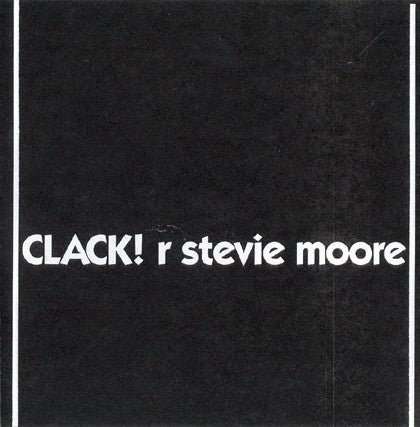MOORE, R. STEVIE - Clack!
"In Fall 1979, R. Stevie Moore squeezed into a midtown Manhattan building at 56 West 45th Street, entered a tiny 8th floor jingle studio run by Englishman Tom Clack, and proceeded to bond bigtime with ambitious engineer Jon Child (who Uncle Harry Palmer had earlier sought out to assist in assembling the original PHONOGRAPHY album) to create one of his greatest collections of music. Still awestruck by his recent move north, R. Stevie first met Jon & Tom when the studio was utilized for compiling the DELICATE TENSION LP. With a cache of great new songs & experiments, he now was set, aimed to break down all barriers and collect audio styles galore in a “professional” 8 track environment, a major jump from mere tapedeck home demos. The project extended well into the next year (decade). Those many sessions are gathered on this 60 minute masterpiece, simply titled “CLACK!” from which many of Moore’s greatest all-time hits emerged." (Official album description via rsteviemoore.com)
“The ‘80s were R. Stevie Moore’s period of greatest exposure, and he started the decade off in style with an album of songs that would eventually become some of his most famous tunes. Clack! is notable also for being Moore’s very first professional studio sessions, recorded in an 8-track jingle studio (run by a gentleman named Tom Clack, hence the onomatopoeic album title) in midtown Manhattan in late 1979. The sonic difference between this album and Moore’s homemade ‘70s tapes is astonishing; the new version of “Part of the Problem,” originally recorded in 1978, is not only definitive, it’s arguably Moore’s all-time finest three and three-quarters minutes. More importantly, Clack! includes several other songs that would quickly become fan favorites, including a silly but surprisingly effective power pop rendition of the Big Bopper’s “Chantilly Lace” and the dark-edged new wave synth-pop of “Bloody Knuckles,” both of which garnered a fair amount of college radio airplay in the first half of the ‘80s. The jangly guitar rock of “Teen Routines” and “You Always Want What You Don’t Have” accurately predicts the Hoboken sound that would sweep over Moore’s adopted northern New Jersey home in the ensuing decade, and the stomping “Conflict of Interest” and the thrilling falsettos of “U.R. True” are both vintage new wave and prime R. Stevie Moore.” - Stewart Mason, All Music Guide
“I’ve been digging into the overwhelmingly extensive catalog of the DIY iconoclast and self-proclaimed genius, R. Stevie Moore. He’s released somewhere in the range of 400 albums over the last thirty-odd years, which has to make him one of the most prolific artists of all time. Moore is clearly an influence on Ariel Pink and his followers like John Maus, Gary War, Geneva Jacuzzi... you get the idea. Clack!, from 1980, is a good demonstration of Moore’s diverse range. It jumps from a Big Bopper cover to bass-driven post-punk to straight-up country, and it’s full of weird pop gems. Highly recommended, guys.” - Top Of The Dial music blog
“Along with Phonography, this is surely one of the best places to start at in R.S.M.’s catalog. It was the first of his albums to be recorded in a professional studio and contains many of his greatest hits including personal favorite “Part of the Problem.” Absolutely nothing can prevent some of these songs from being the wackiest, yet also the happiest and funnest you may ever hear. Anyone enjoying Ariel Pink’s music has a big reason to thank R. Stevie Moore and should look into his music very soon.” - Beyond Ultra Hits music blog
-
Sale
- Regular price $22.00


